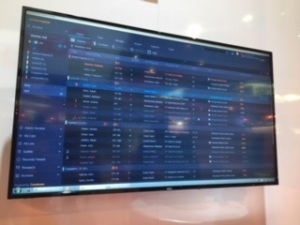by
John R. Fischer, Senior Reporter | November 28, 2017

Carestream's Workflow Orchestrator
CHICAGO — Carestream Health is set to release a new tool on the market in 2018 to enhance quality and ensure faster response times in radiology reading workflow.
The company unveiled its Workflow Orchestrator, a new solution offered as part of its 12.2 Clinical Collaboration Platform and one that determines the ideal radiologist for reading a specific exam based on their sub-specialties, qualifications and availability, at the Radiological Society of North America (RSNA) 2017 annual conference.
“Instead of the radiologists looking for what exam to read next and wasting time, with our system, the exam is looking for the perfect radiologist to read it,” Tomer Zonens, the worldwide product line manager of health care information solutions at Carestream, told HCB News. “This maximizes the capability that each exam is read by the right subspecialist, by the most affiliated radiologists, the local radiologist or the one assigned and the one that is most available.”



Ad Statistics
Times Displayed: 78539
Times Visited: 2794 Ampronix, a Top Master Distributor for Sony Medical, provides Sales, Service & Exchanges for Sony Surgical Displays, Printers, & More. Rely on Us for Expert Support Tailored to Your Needs. Email info@ampronix.com or Call 949-273-8000 for Premier Pricing.
Traditional organization of exams is carried out in the form of filter-based worklists, which are based on the convenience of the radiologist rather than their subspecialties, qualifications, and important factors of each exam.
The zero-footprint solution determines the most suitable reader on a case-by-case basis by assessing the priority status of exams, the subspecialties and workload balance of the radiologist, and relationship management, breaking down information into different sub-worklists, such as trauma and stroke or inpatient and outpatient exams.
The Workflow Orchestrator also ensures fast response times by tagging exams with a service level agreement value. It incorporates important facts, such as the location and type of procedure, patient background information and the name of the referring physician who, if he or she wishes, can place requests for specific radiologists to read exams. Other capabilities enable the correction of data and the addition of specialties for radiologists.
Zonens says the tool is mainly geared toward large and regional providers and teleradiology groups but could also benefit community hospitals.
“We want to optimize the group level, or the facility or the hospital level,” he said. “When we look at value, we need to look at value in the hospital. Obviously, if it’s a larger network, we need to look at it from a global scale.”
The solution is currently live and in beta at Renaissance Imaging Medical Associates in Los Angeles, with its release planned to take place in February 2018.
Back to HCB News

